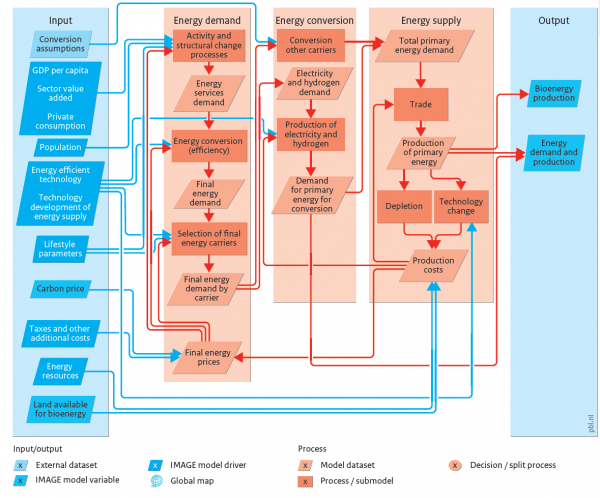Energy - IMAGE: Difference between revisions
No edit summary |
No edit summary |
||
| Line 13: | Line 13: | ||
</figure> | </figure> | ||
</div> | </div> | ||
<div style="clear:both"></div> | |||
Latest revision as of 12:48, 13 January 2017
| Corresponding documentation | |
|---|---|
| Previous versions | |
| Model information | |
| Model link | |
| Institution | PBL Netherlands Environmental Assessment Agency (PBL), Netherlands, https://www.pbl.nl/en. |
| Solution concept | Partial equilibrium (price elastic demand) |
| Solution method | Simulation |
| Anticipation | Simulation modelling framework, without foresight. However, a simplified version of the energy/climate part of the model (called FAIR) can be run prior to running the framework to obtain data for climate policy simulations. |
The IMage Energy Regional model, also referred to as TIMER, has been developed to explore scenarios for the energy system in the broader context of the IMAGE global environmental assessment framework IMG_DeVries_2001IMG_vanVuuren_2007a. TIMER describes 12 primary energy carriers in 26 world regions and is used to analyse long term trends in energy demand and supply in the context of the sustainable development challenges.The model simulates long-term trends in energy use, issues related to depletion, energy-related greenhouse gas and other air polluting emissions, together with land-use demand for energy crops. The focus is on dynamic relationships in the energy system, such as inertia and learning-by-doing in capital stocks, depletion of the resource base and trade between regions.
Similar to other IMAGE components, TIMER is a simulation model. The results obtained depend on a single set of deterministic algorithms, according to which the system state in any future year is derived entirely from previous system states. In this respect, TIMER differs from most macro-economic models, which let the system evolve on the basis of minimising cost or maximising utility under boundary conditions. As such, TIMER can be compared to energy simulation models, such as POLES IMG_Criqui_2003 and GCAM IMG_Thomson_2011.
